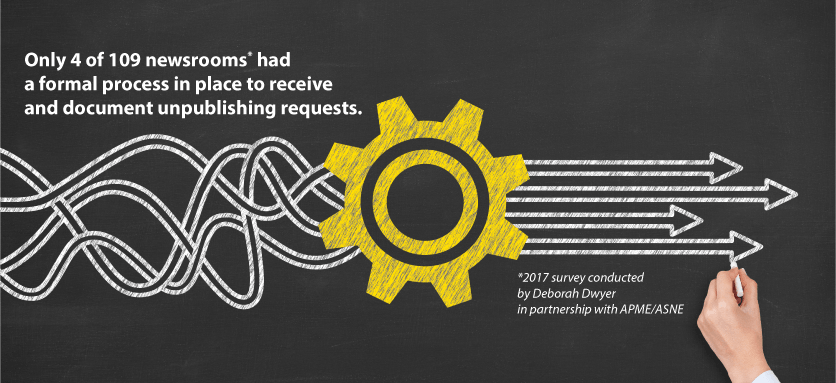
A streamlined unpublishing process is as important as thoughtful policy
An official request process and tracking form are vital — and we want to build you one.If I asked you to give me the basics of your last five unpublishing requests, could you do it? What about the last 10? Twenty? Fifty?
Do you have any history about the requests that were received by the editor before you? If you were to leave, is there a record for the next one?
If you can’t answer these questions, you are in good company. When I surveyed 109 news editors, only four — FOUR! — said they had a system for tracking requests to unpublish.
What a lack of documentation really means for you and for journalism as a whole:
- First, it means you don’t have a streamlined, standardized process for requests. If you don’t have a formal request mechanism like an online form, it’s likely requests creep in via telephone and email to a variety of personnel. (Does your front desk know how to route a call about unpublishing?) Many editors I talk to say they are “pretty sure” they receive all the requests that come in for their news organization, but they can’t be sure some aren’t handled without their knowledge. Even if they did receive them all, they don’t keep track of requests in any standardized way. I hear a lot of “well, I guess I could go through my old emails.”
There is much efficiency to be gained by streamlining your request process. If a potential requestor knew your general stance and requirements to consider a request, could you potentially stave off some of them? And think of the time it can take to go back and forth with a person making a request, especially if it concerns a crime. Is there more information you need, for example, about a charge being reduced or a conviction being expunged? Did they give you the exact URL of the content in question, or at least the date of publication? How much easier would it be if you had that information provided with the request?
- Second, no documentation means no history from which to review your unpublishing decisions as a whole. Are you making consistent decisions when faced with requests concerning the same criminal charges, for example? Is there a category of request that you’re dealing with consistently that might need to be investigated further? How might having that documentation inform future decisions, making them more consistent and equitable? Better yet, how might it hold the news organization accountable regardless of who sits in the editor’s office? You also never know if legal might need this type of documentation one day.
- Last, how might some basic data about what your newsroom encounters with unpublishing help the industry as a whole? To date, unpublishing has stumped the industry when it comes to developing consistent standards. I believe one reason for that is that we only have anecdotal reports from which to consider all of the issues.
Think about what we could do if we knew just these basics:
- Total number of requests
- Type of requests (e.g. crime, safety, source remorse)
- Type of content (article text, photos, videos, audio, captions, etc.)
- Number of requests ultimately approved
- Resolution (Was an article totally removed? Someone’s name anonymized? Was a follow-up story written?)
If you haven’t guessed by now, I have a plan!
Partnering with a team from The Chattanooga Times Free Press, we are building a request form and back-end tracking system to streamline the process and provide a historical document for future review and decision-making. Although each newsroom may have specifics that need to be customized, the simple Google form will be easy for any newsroom to implement or alter. The form will feed a file on the back end in which newsrooms can add information to the request form data to further track and document actions related to that decision, including how they were resolved. Both resources will be made available to news organizations that wish to use them once they are tested and refined.
I know what you’re thinking: A form will just invite more requests! Perhaps, but I suspect, if we do it right, what you will gain in efficiency will more than make up for that.
We won’t be the first to develop a form. Some organizations including Cleveland.com, The Gazette in Iowa, and the Southeast Missourian have formalized their request processes. They serve as guidance for our work. Here are just a few of the multitude of factors we know we must thoughtfully consider:
- Ensuring the request process is secure and identities of those making the requests are protected
- Securing the back-end tracking document, including limiting access and storing sensitive information about the nature of the request
- How to balance our requirements, such as what basic documentation we expect related to criminal charges, to ensure we are not discriminating against those without the means or agency to provide it
Do you have an idea as to what we should include? I’d love to hear from you.
If I haven’t convinced you yet that formalizing your process is important, I have one more issue to raise. Journalists’ credibility relies on providing the public the facts. We report based on evidence and proof. When it comes to unpublishing, shouldn’t we hold ourselves to the same standard?
As I mentioned, this information will also contribute to a better understanding of how unpublishing is affecting our industry across organizations and mediums. It will also provide us with better ways to respond to requests to unpublish.
This will require news organizations to share baseline data (no names or identifying information, of course) with a researcher like me, but that’s the next step we’ll talk about soon.
